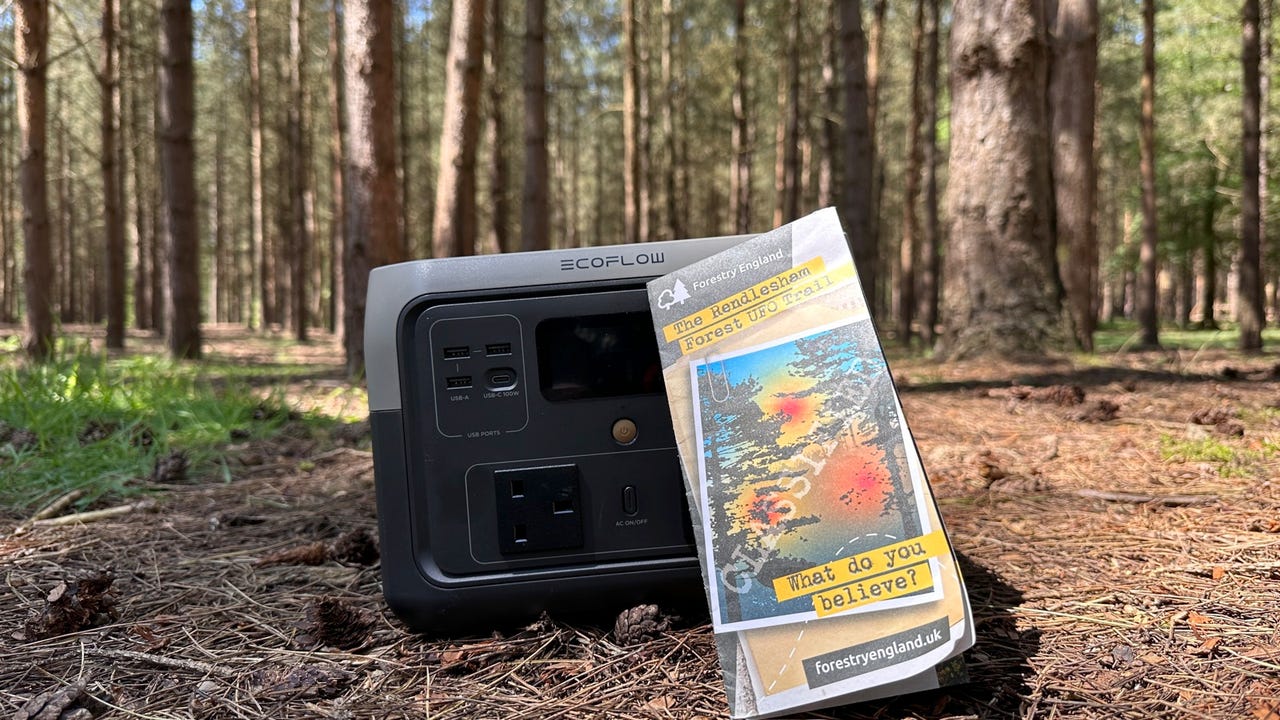
































A EcoFlow River 2 Max powering my search for UFOs (well, the sun!)
Adrian Kingsley-Hughes/Power stations -- think power banks, only much bigger -- are all the rage, and I've tested several over the past few months. But while most power stations come with the option of charging using solar panels, since I'm in the U.K., I don't get to see that glowing orb in the sky all that often.
Also: I tested this tiny satellite communicator on an off-grid adventure. Here's my verdict
Over the past few days I've been down in a place called Rendlesham Forest, and if that name is familiar to you, that's because it's biggest claim to fame is that back in December 1980 it was the location of Britain's own Roswell UFO incident.
Where better to go to see glowing orbs in the sky and test solar panels!
Also: iPhone overheating? Here are 8 potential causes and their solutions
On my travels I've noticed more and more people use power stations with solar panels attached to power their off-grid adventures, but I often see the solar panels set up incorrectly, significantly diminishing the amount of power they can capture from the sun, and dramatically increasing the time it takes to charge up their power station.
Here are my top tips for maximizing the power you capture from your solar panels. Here I'm using theEcoFlow River 2 Max and a160W solar panel .
The EcoFlow River 2 Max along with a 160W solar panel
Adrian Kingsley-Hughes/Yes, I get it that folding solar panels are big and unwieldy, need a big space to set up in, and catch the wind, but always open out your panel completely when in use.
Also: Traveling soon? Take these 4 tech essentials on your summer trips
You want the spot where you'll set up your solar panels to be as flat as possible and have as clear and as unobstructed view of the south sky as possible (if you're in the northern hemisphere, otherwise it's the northern sky you need).
Most panels come with a stand, and it makes sense to use them as this gives the best possible angle to the sun.
Prop up your solar panels, either using the supplied stand, or against a wall, tree, or vehicle
Adrian Kingsley-Hughes/You can lie the panels flat on the ground or a roof if it's windy, but the efficiency drops dramatically.
Laying the panels down flat really hits their efficiency, but can be the only way to use them in high winds
Adrian Kingsley-Hughes/You want to keep shadows off your solar panel as much as possible, as even a small one can really hit efficiency.
This shadow knocks a good 30 percent off the efficiency of the panel
Adrian Kingsley-Hughes/Oh, and remember, as the sun moves east to west (in the northern hemisphere), the shadows will move west to east as the day progresses.
Keep the power station out of the sun to maximize charging speeds. The hotter the power station is, the slower it will charge. If possible, I tuck it behind the solar panels.
A hot power station will charge at a slower rate than a cool one, which is why I like to keep them tucked behind the solar panel
Adrian Kingsley-Hughes/The sun moves during the day, but if you don't want to be chasing it all day, point the panels towards the south (in the northern hemisphere) to capture the strongest noon sun.
Also: Run your Raspberry Pi off-grid with solar power. Here's what you need
Not sure which way is south?
Put a stick in the ground and look at the shadow. The closer it is to noon, the closer the shadow will be to pointing north (again, in the northern hemisphere, reverse if you're in the southern hemisphere). If you want to capture the most sunlight, use the stick in the ground stick and have the shadow pointing directly to the middle of the panel (remove the stick when you're done orienting the panel to maximize the sunlight you're capturing!).
Shadows point directly north at noon in the northern hemisphere
Adrian Kingsley-Hughes/ Tags quentes :
Nosso processo
Home & Escritório
Tags quentes :
Nosso processo
Home & Escritório